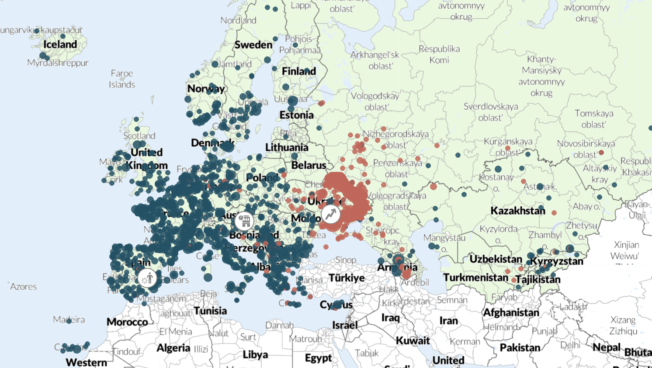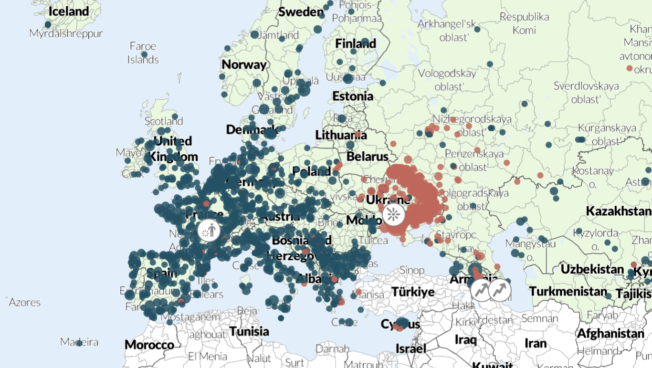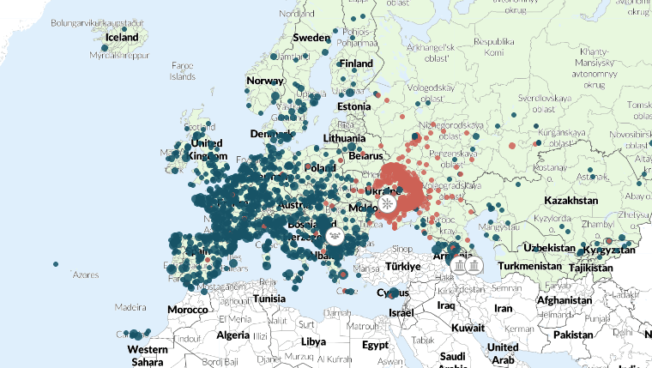Regional Overview
Europe & Central Asia
April 2024
Posted: 9 May 2024
 Armenia-Azerbaijan: Border delimitation triggers protests
Armenia-Azerbaijan: Border delimitation triggers protests
On 19 April, Armenia and Azerbaijan announced the start of border delimitation in the area of Armenia’s northeastern Tavush region.1Ministry of Foreign Affairs of Armenia, ‘Press release on the outcome of the 8th meeting of the State Commissions on the delimitation of the state border between Armenia and Azerbaijan,’ 19 April 2024 As a result, Armenia will return to Azerbaijan several border villages it has occupied since the early 1990s. The move prompted a wave of protests in the Tavush region and across Armenia. Fearing partitioning or the handover of Armenian border villages, participants blocked roads, including a critical highway linking Armenia with Georgia, and attempted to hinder demining in the area being delimited. Police responded by unblocking roads and detaining some participants. Demonstrations and road blockades also occurred in the capital city of Yerevan, where police detained 96 participants in a march organized on 24 April by the National Democratic Axis movement, which vehemently opposes concessions to Azerbaijan.
Prime Minister Nikol Pashinyan has been at pains to persuade residents of border areas and opposition that delimitation could help dissuade Azerbaijani incursions into Armenian territory and expedite a peace treaty.2Patrick Wintour, ‘Armenian PM defends decision to give four villages to Azerbaijan,’ Guardian, 22 April 2024 In April, ACLED records 41 allegations of gunfire along the two countries’ borders, all in the weeks prior to the announcement of the border deal, after seeing none in March and only sporadic incidents in the previous five months. Tensions escalated around 5 April when the European Union and the United States pledged support for Armenia’s reform agenda and refugee relief.3European Commission, ‘Joint EU-US-Armenia High Level Meeting in Support of Armenia’s resilience,’ 5 April 2024
Meanwhile, around 17 April, Russian peacekeepers stationed in and around the former Artsakh4The disputed territory of Nagorno-Karabakh is internationally recognized as part of Azerbaijan. ACLED refers to the former de facto state and its defunct institutions in the hitherto ethnic Armenian majority areas of Nagorno-Karabakh as Artsakh — the name by which the de facto territory used to refer to itself. For more on methodology and coding decisions around de facto states, see this methodology primer. began early withdrawal of personnel and equipment to Russia. The 2,000-strong contingent was deployed in the aftermath of the war over Artsakh in autumn 2020 and did not hinder Azerbaijan’s forceful takeover of the separatist enclave in September 2023, which prompted the exodus of its entire ethnic Armenian population. Additionally, on 26 April, the joint Russian-Turkish ceasefire monitoring center in Aghdam — another relic of the 2020 war — was shut down.
 Georgia: Resuscitated foreign influence bill prompts protests
Georgia: Resuscitated foreign influence bill prompts protests
On 3 April, the ruling Georgian Dream party reintroduced the foreign influence bill, shelved after the previous attempt to adopt it in March 2023 led to mass demonstrations. Apart from dropping the ‘foreign agent’ designation, which carries negative connotations in post-Soviet countries, the Russia-style bill remains unchanged — it requires civil society and media organizations receiving 20% or more funding from abroad to register as promoting foreign influence.5Joshua Kucera, ‘Why Georgia’s Government Is Trying (Again) To Introduce An Unpopular ‘Foreign Agents’ Law,’ Radio Free Europe / Radio Liberty, 4 April 2024 Daily protests in the capital and major cities ensued, with the number of participants and tensions increasing as the bill was inching toward the floor. Police responded to demonstrators’ attempts to break cordons around the parliament with detentions and alleged beatings, including of politicians and journalists. On 29 April, the Georgian Dream party bused thousands of people into Tbilisi for a rally in support of the bill, during which its tycoon leader Bidzina Ivanishvili lashed out at foreign meddling and threatened the opposition.6Civil.ge, ‘Bidzina Ivanishvili Backs Anti-Western Policies, Threatens Repressions,’ 29 April 2024 The following day, on the eve of the second reading, police dispersed demonstrators against the bill with pepper spray and water cannons and detained over 60 people. A final pro forma reading is due mid-May. President Salome Zourabichvili vowed to issue a veto on the draft law, but Georgian Dream has enough votes in parliament to override the presidential veto. At the end of 2023, Georgia received EU candidate status, conditional on its implementation of democratic reforms.7European Council, ‘Georgia,’ accessed on 7 May 2024 A general election is due in October 2024.
 Russia: Oil infrastructure and airfields under drone attack
Russia: Oil infrastructure and airfields under drone attack
Ukraine carried out targeted strikes on Russian oil infrastructure and airfields throughout April, including multiple drone strikes in Tatarstan, which is located some 1,200 kilometers from the border with Ukraine and had hitherto seen no drone attacks. On 2 April, a Ukrainian drone hit the area surrounding a Shahed-series drone assembly plant in Yelabuga, Tatarstan. The drone damaged a nearby dormitory hosting Russian and foreign students reportedly working at the plant, injuring 14 of them. Another drone set fire to an oil refinery in the same region. Oil terminals and refineries also came under drone attacks in the Smolensk region on three occasions. On 27 April, a massive drone attack targeted two oil refineries in the Krasnodar region.
Russia denied that Ukrainian drones damaged multiple military aircraft at airfields in the Krasnodar, Kursk, Saratov, and Rostov regions on 5 April and an oil pipeline near the port town of Azov in the latter region on 6 April. Another Ukrainian drone attack targeted a military airbase in the Voronezh region on 24 April. Overall, the number of drone strikes on sites within Russia’s internationally recognized borders climbed a further 7% after nearly doubling in March, likely in response to increased Russian targeting of Ukrainian positions along the frontlines and border regions with highly destructive aerial bombs.
 Ukraine: Russia ramps up pressure on the Donetsk region
Ukraine: Russia ramps up pressure on the Donetsk region
In April, ACLED records over 1,000 battle events in Ukraine — nearly 20% more than the average in the previous six months since the start of Russia’s counterattack in October 2023. A similar peak in fighting was last observed at the height of the Ukrainian counter-offensive in July 2023. The spike came as Russian forces exploited Ukraine’s shortages of ammunition and personnel to occupy as much land as possible before the arrival of relieving supplies. On 20 April, the US House of Representatives approved the $61 billion assistance package for Ukraine that had stalled for six months due to Republican opposition. Earlier, on 11 April, the Ukrainian parliament passed the much-delayed mobilization law, after President Volodymyr Zelenskyi lowered recruits’ minimum age from 27 to 25 years.8Marc Santora, ‘Ukraine’s Parliament Passes a Politically Fraught Mobilization Bill,’ New York Times, 11 April 2024 The new mobilization procedures will also affect Ukrainian men abroad, as they will have to update their information with a draft office to be able to apply for consular services.9Serhiy Morgunov, David L. Stern, and Francesca Ebel, ‘Ukrainian men abroad voice anger over pressure to return home to fight,’ Washington Post, 3 May 2024
As in March, over 75% of battles occurred in the Donetsk region, where Russian forces occupied an additional seven settlements in April, mostly in the area of Ocheretyne northwest of Avdiivka, after penetrating a Ukrainian defense line. Significant fighting also occurred in the area of Chasiv Yar west of Bakhmut. Speculation is rife on whether Russian forces have enough reserves and materiel to step up their offensive, including targeting Ukraine’s northeastern Sumy and Kharkiv regions.10Economist, ‘A fresh Russian push will test Ukraine severely, says a senior general,’ 2 May 2024
At the same time, levels of Russian airstrikes and shelling slightly decreased compared with the six-month average. The Dnipropetrovsk and Kherson regions experienced over 20% increases each, however. Indiscriminate targeting particularly affected civilians in the border areas of the Sumy region and in Kharkiv, Kherson, and Odesa cities, with Odesa subjected to repeated strikes with ballistic missiles, including those carrying cluster munitions. Russian forces also launched barrages of drones and missiles explicitly targeting the country’s energy infrastructure on 10 to 12 April and 27 April, damaging power plants and gas facilities. Russian missiles completely destroyed one of the largest thermal power plants south of Kyiv city as Ukrainian air defense units allegedly ran out of interceptors.11Amna Nawaz, Dan Sagalyn, and Sam Lane, ‘Exclusive: Zelenskyy says without U.S. aid ‘we’ll have no chance of winning,’ PBS, 15 April 2024 Likely anticipating the deliveries of aid, Russian forces also increasingly targeted Ukraine’s rail and port infrastructure.
For more information, see the ACLED Ukraine Conflict Monitor and ACLED Brief ‘Russia Ramps Up Airstrikes on Ukraine’
See more
See the Codebook and the User Guide for an overview of ACLED’s core methodology. For additional documentation, check the Resource Library. Region-specific methodology briefs can be accessed below.
Links:
For additional resources and in-depth updates on the conflict in Ukraine, check our dedicated Ukraine Crisis Hub.







